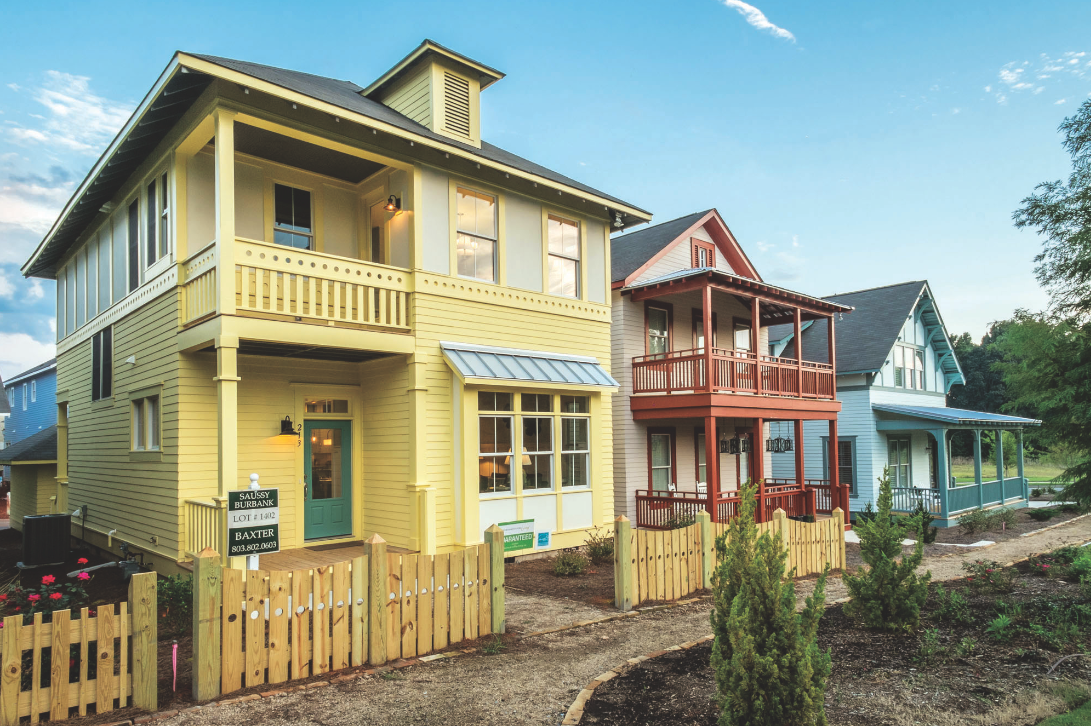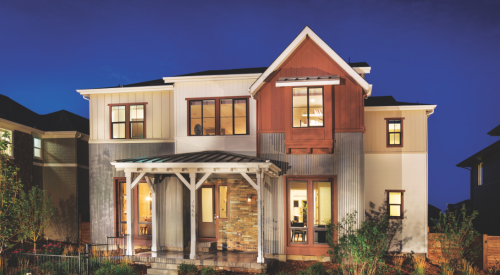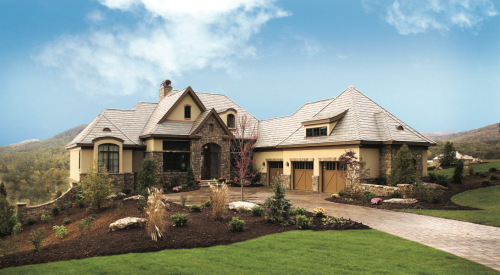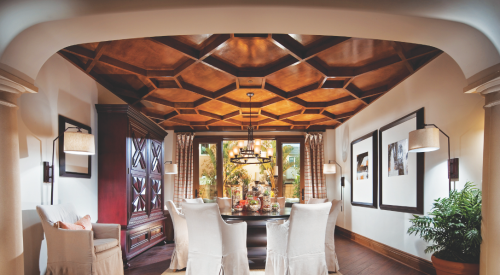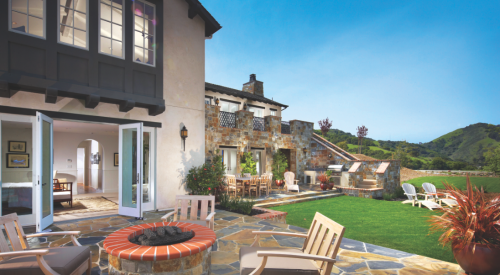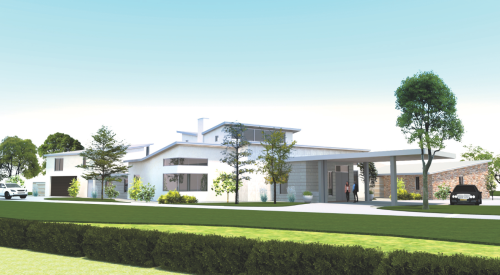Sales at new communities around the United States indicate a smartly designed, small single-family home that optimizes both indoor and outdoor living space can make buyers forget about its size. Such homes appeal to multiple market segments including first-time buyers, young families, and empty nesters. And builders can hit a lower price point with a product that isn’t a townhouse or a condominium.
For this article, we collected five examples and asked the architects and builders to analyze what makes them tick.
Unique designs dazzle Denver buyers

The fresh, zesty character called for in the Midtown design guidelines is embodied in two elevation choices for Residence Two: modern/Prairie style (shown here) and contemporary. The private courtyard on the side of the house is filled with light from an abundance of windows. Photos: Ron Ruscio Photography
The 1,997-square-foot Residence Two is part of the Signature Collection at Midtown, an infill community five miles from downtown Denver that has been a smash since it opened in March 2013. According to Perry Cadman, general manager for Brookfield Residential in Englewood, Colo., Residence Two is the best-selling plan in the collection, where 72 homes have been sold to date.
Given plenty of creative freedom by Brookfield, three different architects designed six homes for the collection. Residence Two was designed by Steve James, founding principal of DTJ Design, Boulder, Colo., who focused on leveraging a 35-foot lot with 10-foot-wide side yards. “Perry asked only for a great house that would hit a $300,000 price point,” James says. “It was very refreshing.”

The optional bench in the foyer offers a place for guests to leave muddy shoes and wet umbrellas. No aspect of cottage detailing was overlooked, from the white wainscoting, paneling, trim, and crown moldings to the brackets under the shelves.
The side yard—previously a drainage corridor—became a courtyard that the one-room-deep home envelops, bathing it with light. “It’s basically merchandised like a loft with fresh, open spaces, lots of windows and sliding doors, and clean, simple interior décor,” he says. “When you walk into the foyer, you look right through a glass box to the garden courtyard.”

Residence Two starts as a two-bedroom plan, but the study converts to a third bedroom, and the finished basement (a standard feature) adds even more bedroom space. Illustration: DTJ Design
Examples of progressive design include a conservatory in the second-floor master bedroom and a master bathroom that’s actually two separate bathrooms connected by an oversized shower. The U-shaped kitchen is at the front of the house, allowing homeowners to keep an eye on their children playing in the front yard.

Architect Steve James split the master bath into two separate bathrooms, each with a vanity, toilet, and closet. The halves meet in an oversize shower.
Brookfield managed to build an energy-efficient home even with a robust window package that includes frosted glass on the privacy wall, high glass in the great room, and 10-foot sliding doors. “All that glazing helps sell the house and makes it feel larger,” Cadman says.
Cottages share green space

The Garden Cottages at Baxter Village face green space that is shared by residents. The bold color palette includes yellow, green, and blue body colors accented by white, bright-red, or electric-yellow trim. Photos: Zan Maddox/Social Design House
The Portland snagged a 2013 Best in American Living Award and is winning the hearts of buyers as well. The 1,740-square-foot, two-story home is one of the Garden Cottages at Baxter Mill, a traditional neighborhood development in Fort Mill, S.C.
“The Garden Cottages are the last piece of Baxter Village, so we wanted to do something interesting and fun,” says Jim Burbank, chairman of builder Saussy Burbank, Charlotte, N.C. Burbank also wanted to keep prices in the low $300,000s.

There’s no wasted space in this floor plan, which has the kitchen, dining room, great room, and laundry room on the first floor and the bedrooms upstairs. “We eliminated the spaces people use for holidays or visitors, such as the formal dining room,” Aschenbrenner says. “Then we looked for every opportunity to do great but simple built-ins.” Illustration: 505 Design
The architect, 505 Design of Charlotte, N.C., conceived a series of alley-loaded homes with shared green space in the front. “The lots are 35-feet wide by 90-feet deep,” says 505 partner Alan Aschenbrenner. “Our challenge was to maximize square footage to make the homes livable and meet the desired price point, but be sensitive to the fact that they’re 10-feet apart.”
The Portland is attracting young couples who either have children or are planning a family. “It’s a great home for first-time buyers that want to be within walking distance of a great school and are willing to share common open space,” he says. However, they do have a 15-foot-deep space between the home and the detached garage that can be used as a private outdoor room.

High ceilings and tall upper cabinets make the kitchen and dining room feel more expansive. Visible at left is the laundry room, which has a drop zone with shelves and cubbies for frequently used items. There’s also a storage room off the dining area.
Aschenbrenner says the jumping-off point for the elevations was a Victorian design in the Baxter Village pattern book. “We took that style and overlaid what we thought we meant by cottage style, which was more about authentic, honest details,” he says.
To date, Saussy Burbank has sold 35 of 70 Garden Cottages. The Portland accounts for approximately one-fifth of those sales.
New homes lure techies in upstate New York

One of three elevations offered for the Saratoga has a hip roof with brackets and an eyebrow window over the garage. The front porch extends beyond the garage, lessening its impact on the streetscape. Photos: Randall Perry Photography
Anticipating an influx of high-tech jobs in the region, Malta Development of upstate Malta, N.Y., is setting out to capture employees at the new microchip plants as well as young couples and 50-plus buyers from the local market. BartonPartners Architects, Norristown, Pa., designed three product lines for Lakeview Landing, the developer’s 160-lot community. The smallest series is the Carriage Collection, with homes ranging from 1,400 to 2,150 square feet.

Malta Development works hard at injecting innovative, modern touches in its homes, such as a centrally located command center for charging cell phones, organizing mail, and managing schedules, as well as an updated mudroom with built-in benches and cabinetry. Illustration: BartonPartners Architects
The 2,022-square-foot Saratoga has a starting price of $398,800 and is one of the hottest selling Carriage homes. The single-story, open-concept plan has vaulted ceilings in the kitchen, breakfast room, great room, and master bedroom. The private study could be used as a guest room or fourth bedroom. The L-shaped, roomy front porch wraps around a secondary bedroom and is perfect for outdoor relaxation.

A stacked-stone fireplace flanked by custom built-ins is the focal point of the great room.
Tasked to create a fresh look for Lakeview Landing, BartonPartners designed “very traditional, Craftsman-style elevations that would go well in an Adirondack community,” says Bill Warwick, principal.
“At the moment, the Carriage homes are far and away the most popular,” says Beth Smith of Beth Smith Realty in Malta. Of 18 sales at Lakeview Landing to date, 14 have been Carriage homes. So far, the buyers are predominantly empty nesters.
Small-lot detached captures young professionals

Inspired by classic Mediterranean homes, Residence Two uses gable roofs, half-round attic vents, shared metal accents, louvered shutters, and wainscoting to create a Tuscan façade. Photos: Julio Duenas/Creative Noodle
Encoure at Harlan Ranch, a master-planned community in Clovis, Calif., was slated for townhomes until the recession hit. That’s when Fresno, Calif.-based Wilson Homes decided to switch to detached homes on small lots.
“Leo Wilson and Bill Hezmalhalch targeted the buyers very carefully and came up with the concept of very efficient, small, single-family homes of variable widths so that they wouldn’t look so cookie-cutter,” says Ron Nestor, senior principal with William Hezmalhalch Architects, Santa Ana, Calif. “Once Encoure was built, it became the best-selling project in California during the recession.”

Residence Two, also known as the Trendsetter, targets two single young professionals with its split garage arrangement. Bedroom 2 has an adjacent full bath, while bedroom 3 has a walk-in closet. Two linen closets instead of one enhance storage space. Illustration: William Hezmalhalch Architects
Wilson has been attracting employees from a nearby hospital, some of whom are two young doctors or two nurses pooling their resources to purchase a home. Residence Two is a 1,608-square-foot plan designed for this type of buyer. The garage is split into two bays, one on each side of the covered entry. The great room, kitchen, and dining area unfold to the rear. Upstairs is a master suite, two additional bedrooms, a full bath, and a laundry room.
To make the great room, kitchen, and dining room feel as large as possible, Hezmalhalch designed an island kitchen and specified 9-foot ceilings on the first floor.
The back yard is admittedly small, “but there’s an indentation to create a bigger patio space,” Nestor says. “Most people have dogs, so the yards are sized to accommodate them, too.”

Although the yards are small, there’s enough space for a patio with a fire pit, a dining area, and various seating options.
Encoure’s variety of elevation styles, with their mixture of materials and colors, conveys the feeling of an older, established neighborhood. “Most of the homes have stone or brick accents, which gives them more texture and richness,” he says. “Even the garage doors have special handles and hinges. They’re like little bits of jewelry on the house.”
Of 148 Encoure homes released to date, Wilson has sold 63. The buyers are a diverse group that includes young professionals, retired Baby Boomers, and divorced or widowed individuals.
Tweaking a popular floor plan

The Madison’s extended roof and shed dormer give it character. The covered porch is as large as some interior rooms. Photos and Illustrations: Ross Chapin Architects
Langley, Wash., architect Ross Chapin is constantly updating his portfolio of cottages and small houses. One of the newest additions is the Madison, a 1,739-square-foot, two-story home that has its origins in Chapin’s popular Madrona plan. Here’s what he did:
• The rear half of the Madrona has a bedroom, a full bath, a laundry room, and a study with access to a deck. In the Madison, this portion of the house has been modified with a bedroom extension and rear access to an attached garage.
• A classic 12:12 gable roof incorporates living space within the roof volume. “It’s not a cap on a box,” Chapin says.

The Madison is a new, master-down plan with an attached garage that minimizes wasted space and maximizes the charm and livability of every room.
• Active rooms are positioned toward the front, while private rooms are placed either toward the back or on the second floor.
• The home has the ability to nest with neighboring houses because it can be open or closed on either side.
• The main level features an open living area, dining area, and kitchen. There are no duplicate rooms, such as a breakfast room in addition to the dining room or a family room in addition to a living room.

A widened stair landing accommodates a sitting/sleeping alcove—“a guest room in a pinch,” says architect Ross Chapin.
• The central hall and stair help minimize circulation space.
• To accommodate the 50-plus buyer, the main bedroom suite is on the ground floor and secondary bedrooms are upstairs. A third level can be added with a loft.
7 ways to design better small homes
• Include one room that can serve a number of uses: home office, study, living room, or dining room.
• A kitchen with a simple L-shape allows for easy flow and usability. Try adding an island with a raised bar-top to create an eating area and help minimize the view of the countertops.
• Place windows at the end-of-view corridors to provide a clear view from the front door throughout the home. Where it makes sense in the floor plan, try to incorporate windows on both sides of a corner to enhance visibility through the room.
• In homes that have 10-foot ceilings on the first floor, add interior transoms to borrow light and brighten up the interior of the home.
• Find places throughout the home for built-in shelves so that buyers won’t have to depend on furniture for storage.
• Pop out a small sitting area in the master bedroom to give it elbow room.
• Opaque or frosted glass on windows facing the neighboring house will give it privacy (so homeowners won’t need to keep their drapes closed). PB
